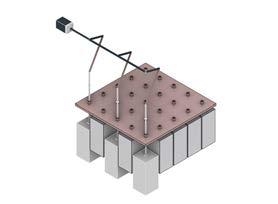
2 minute read
Office-user oriented façade design
from BT Bundle 2020
by RuMoer
Office-user oriented façade design an interactive/adaptive design approach
Users in traditional office buildings often experience discomfort with the indoor environment and have issues with how this is being regulated. Due to the fact that research has shown that users’ satisfaction in an office building, which consists of their comfort and health, reflects on their work productivity, the necessary measures need to be taken in order to be able to suffice the office users’ needs. Also, due to the fact that the building sector in Europe is responsible for an energy consumption of 40% of the final energy use and this leads to high carbon emissions and dependence on fossil fuels, the European Commission has stipulated regulations, where it is stated that all new buildings have to be nearly zero-energy by the beginning of 2021. In addition, because the façade is one of the buildings’ components which has high impact on the indoor comfort and energy use of the building, taking the user’s comfort needs and designing this from the conceptual design phase, can help achieve user satisfaction and enhance work productivity, while also helping achieve nearly energy neutrality.
Advertisement
This research focused on what are the relevant factors of user satisfaction that could be implemented into façade design, while also investigating state of the art interactive/adaptive façade technologies (passive and active) and energy efficient façade
ARCHETYPES
design methods, in order to provide design solutions which optimally satisfies office users’ needs of comfort, and therefore increases work productivity, and also supports nearly energy neutrality of office buildings. This led to the research question of, “How can an interactive/adaptive office building façade element be designed to optimally satisfy its users in order to increase work productivity and to support nearly energy neutrality of office buildings?”.
This research presents office façade designs for specific type of users, namely the Energy Efficient archetype, the Self-Adaptive environment archetype, and the Full-Control of their environment archetype. The evaluation of these design configurations show that it is almost impossible to have one interactive/adaptive façade design that complies with all of the user preferences of all types of users, because every type of user has different preferences and some might contradict each other. Nevertheless, this research concludes on design characteristics derived from the presented design configurations, which show how the most optimal officer-user oriented façade design should function, that can ensure user satisfaction for different types of users and can help its building become nearly energy neutral.
Energy efficient Self-adaptive Full control
ACTUAL ENERGY COMFORT NEEDS
Waster More sensitive to comfort
Saver Less sensitive to comfort Energy and comfort needs per archetype (translated from Dr. M. Ortiz’s study)
Self-Adaptive archetype facade design example:
Demonstration of living glass system




Generic facade design guideline of state of the art technologies linked to Archetype’s preferences

Function of the Self-Adaptive archetype’s facade design

Optimal “all users” design guideline










